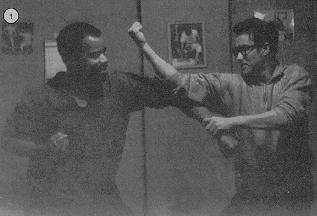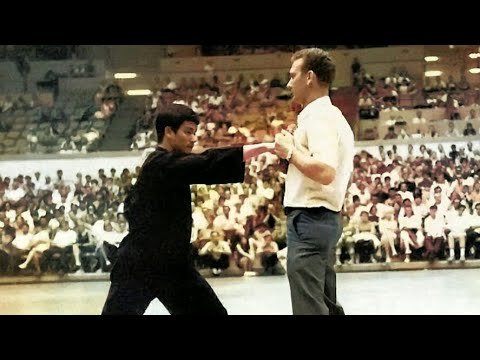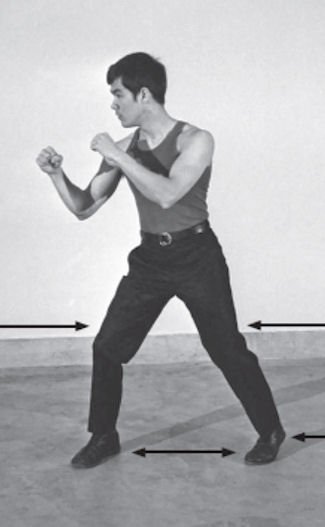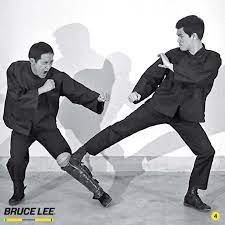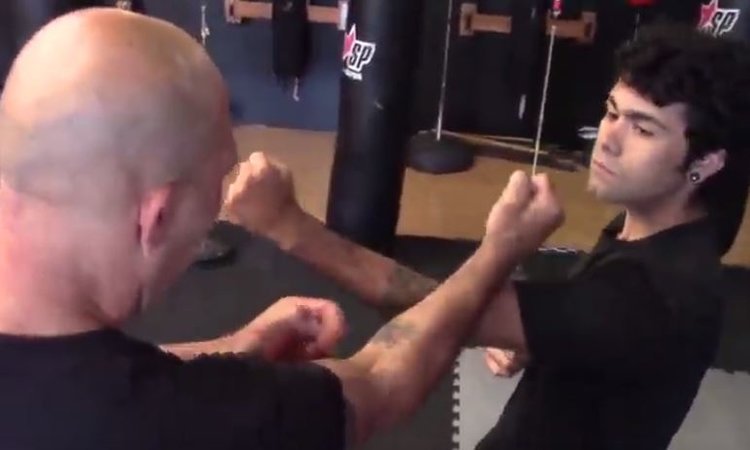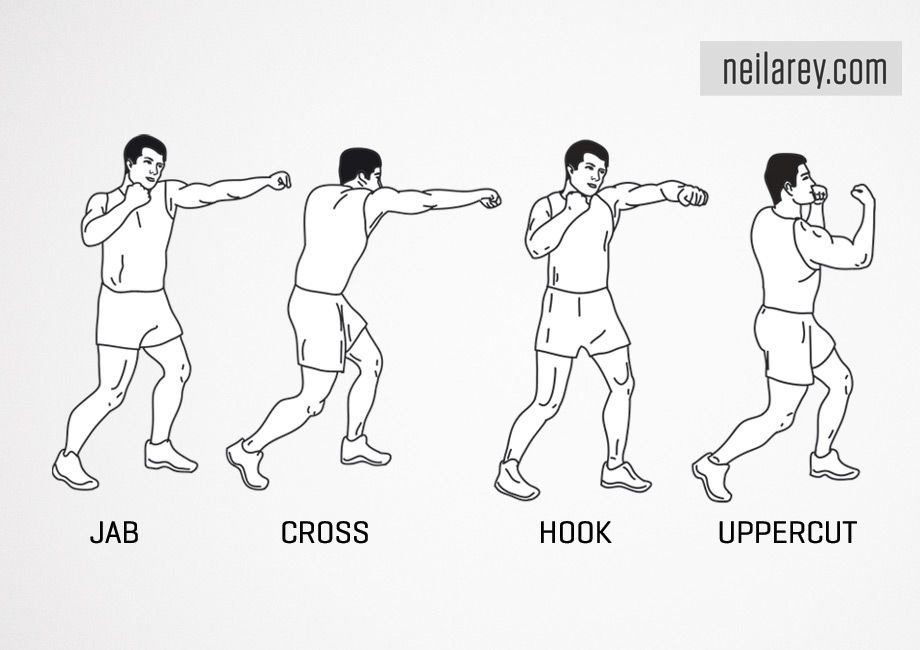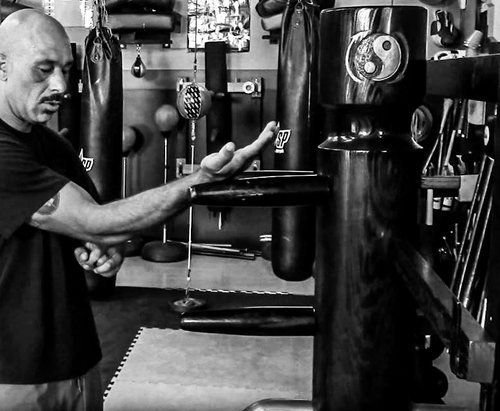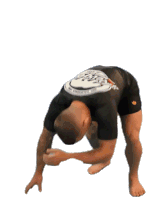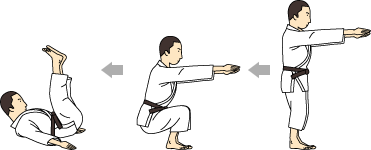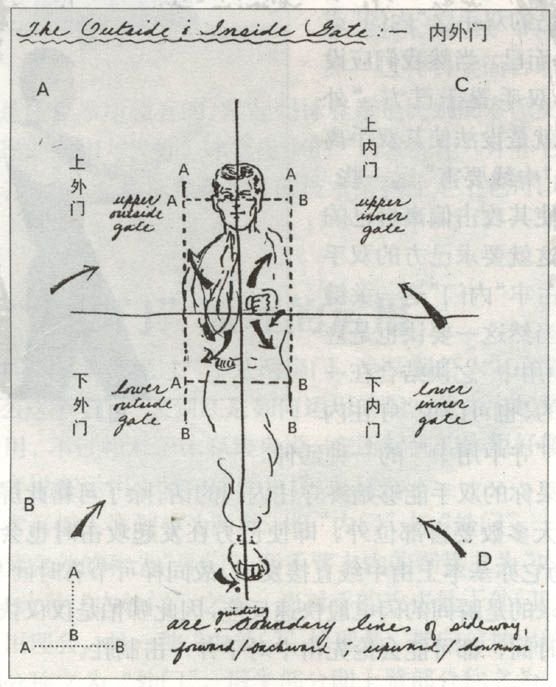Jeet Kune Do Phase 1
Phase 1 Lessons
All Students Must Memorize A-Z, before proceeding to the next level. These are the basics of our system and will prepare you for more challenging systems in the future.
Phase 1 Primary Documents
More Phase 1 Required Reading:
Lesson A: The Salute
The Warrior & The Scholar
The Salute is what we do at the beginning and the end of every class. It represents the duality of life, the Yin and Yang, The Warrior and Scholar.
Lesson B: History
Sijo Bruce Lee grew beyond his foundational teachings of Wing Chun and began calling this new “style” Jun Fan Gung Fu. Jun Fan being Bruce’s native name. Jun Fan Gung Fu is often referred to as “Modified Wing Chun.”
Jeet Kune Do or Jun Fan Jeet Kune Do is another step in Bruce’s progression. It revolves around the core arts of Wing Chun, Boxing & Fencing. It pulls techniques from many other styles, such as savate wrestling and jujitsu. For this reason, many refer to Bruce Lee as one of the grandfathers of MMA. [1967+]
In 1980 the idea of “Conceptual J.K.D.” appeared. This came when the art began adding pieces from many more styles, such as Brazilian Jiu-Jitsu, Muay Thai Kickboxing, Filipino Kali, & Silat. Simply putting it: Since many wanted to retain some of what Bruce was originally teaching, while others saw continued evolution as the ultimate lesson and goal, the name split appeared.
Jun Fan Gung Fu (1962)
Modified Wing Chun
Still taught and Kept alive by Kimura Clan Gung Fu (contact: Sifu Andy Kimura) (Youtube)
Jeet Kune Do (1965)
Called Jeet Kune Do or Jun Fan Jeet Kune Do
Core arts: Wing Chun, Boxing, Fencing.
Sub arts: Savate, wrestling, Jujutsu, and more
Inosanto / Conceptual J.K.D: (1980’s)
Added emphasis on Filipino martial arts and arts like Brazilian Jiu-Jitsu, Silat, and Muay Thai Kickboxing.
According to Sigung Taky Kimura, the main difference between Jun Fan Gung Fu and JKD is the delivery system (modern stance and fencing footwork); we make sure to emphasize fencing principles and the Wing Chun Core with many traditions from boxing to create a basis from which we help you build your JKD growth.
The conceptual JKD aspects incorporated into our curriculum is found in a large portion of our weapon work, street (dirty) grappling, and Rapid Assault Tactics training..
Lesson C: Philosophy
“Jeet Kune Do” means: The Way of the Intercepting Fist
There is too much to cover here in one sitting. Remember the following points, then begin to read and consume as much information as you can.
Core arts of Jun Fan J.K.D:
60% Wing Chun
20% Western Sword Fencing
20% Western Boxing
The Jun Fan (Bruce Lee) System (The mental aspect)
Sticking to the nucleus
Liberation from the nucleus
Returning to original freedom
The Three Stages of Development (The physical aspect)
Partiality
Fluidity
Emptiness
————-
Jeet Kune Do’s first concern is its experience and not its modes of expression.
Jeet Kune Do is only a name. The most important thing is avoiding bias or preference in the training. For example, although the principles of boxing are important, practicality and ‘realism’ are even more important.
In order to cope with what is, one must be flexible and be able to adapt to what the moment is giving you.
“Having the two halves of one whole, which are the straight and the curve, we can truly have choiceless awareness. Choiceless awareness can lead to reconciliation of opposites in a total understanding of combat in its suchness.
Thus, in the highest stage, one is in the center of a circle, and there he stands while yes and no pursue each other around the circumference.
One can achieve that because he has abandoned all thought of imposing a limit or taking sides; he rests in direct intuition, which is returning to original freedom.”
Jeet Kune Do is Fitting in with one’s opponent, but there is no path, no self, and no goal.
A style is a classified response; one’s chosen inclination.
To do a technique is to study oneself in action with the opponent, it is a form of relationship.
Lesson D: Motto and Creed
J.K.D. motto:
“Using no way as way, having no limitation as limitation.”
When there is a specific way, therein lies the limitation. And when there is a circumference (a “completed” concept) it traps and if it traps, it rots; and if it is rotten, it is lifeless.
J.K.D. creed:
“Absorb what’s useful, discard what’s useless, add what is essentially your own.”
Lesson E: Principles
CORE PRINCIPALS:
Simplicity – Daily minimize instead of daily increase
Simplicity is the highest cultivation. Thus, the closer you come to the true way of gung fu, the less wastage of movement you exhibit. Partial cultivation, however, runs to ornamentation. Being good in Gung fu does not mean adding more; it is not decoration; you must be simple like the sculptor, create not by adding but by hacking away at the unessential so that the truth will be revealed. Unobstructed alertness, complete fluidity, will remain.
Effectiveness – Anything that scored
Economy of Motion – Controlling all muscle contractions and tension during the execution of all movements.
In kicking and punching, especially when launched from the ready position, eliminate all unnecessary motions and muscle contractions which slow and fatigue you without accomplishing any useful purpose. Much energy is wasted by the unrelaxed opposing muscles in resisting the movement. Learn and feel proper concentration and recovery (otherwise, your physiological engine is racing, but the brakes are on).
PRINCIPALS:
Centerline Theory -
Primary Targets -
Dominant Side Forward -
Hand/Foot Moves FIrst -
Longest Weapon to Nearest Target -
80% of Attacks from the Front Side of the Body -
Brim of Fire
Immovable Elbow -
5 Ways of Attack -
Broken Rhythm -
Elusiveness -
Fistic Law -
Lesson F: Foundation & Si Lim Tau
Understanding the proper structure for your body and movements is critical to understanding the basis of many techniques we practice. A grasp of the concept of centerline should be emphasized.
"Siu Nim Tao / Si Lim Tau / Si Lim Tow" can be used as a form of moving and breathing meditation. In addition, it increases student concentration and focus. The form is also used extensively to develop proper structure, muscle memory & forward energy in Wing Chun practitioners.
About conditioning drills (5&7 Star Condition Drills)
The human body repairs itself and adapts to the conditions it is put under. For a thousand years, and more recently in modern MMA and the U.S. Marine Corps, body hardening techniques have been applied to condition and strengthen the bones (through microfracture, you allow for healing) the nerves (it dulls the nerves and reduces pain in the area later down the road) and your mental strength (dealing with pain). Start slow, and one day you’ll notice a real difference.
Basic Techniques
Stance
Shifting your base
Blocks
Finger strikes
Punches
Scientific Principles
Elbow position
Four gates
Centerline theory
Mother-line = vertical center mass
Centerline = personnel offense/defense line
Meridian-line = (attacking line) Your Centerline aligns with opponent’s Mother-line
Lesson G: Base Shifting
Yee Jee Kim Ma – Restraining goat stance (The origin/for training only)
Cho Ma - Base shifting from the Yee Jee Kim Ma stance
One foot turns the base
Both feet turn the base
Walking base turns
Turn base with tools in the air
Proper shifting in Wing Chun requires the hips and the feet because it’s what generates the force behind our strikes and blocks. Base shifting allows you to keep your balance and generate power while removing yourself from your opponent’s attacking line.
To be able to base shift correctly, you must understand your basic stances as well... all of this is fairly complex and is best summed up in a video
Lesson Media Resources:
The “Yee Jee Kim Ma” stance
Base Shifting
Lesson H: The Stance
Have Your Dominant Side Forward: Because…
Closer to the opponent
Harder to block
Stronger
Faster
Has greater dexterity
Greater accuracy
More reliable than your non-dominant hand
JKD (By-Jong) Stance Posted by Damjan Visnjic
By-Jong Ready Position – Inside of lead elbow on centerline.
Moving forward into
Moving backward into
Sliding from By-Jong stance into Dung Bo stance & back to By-Jong stance
Pivoting left & right (pivot on front foot first, then rear foot)
Ding Bo Stance – Original Jun Fan Gung Fu stance (Inside of lead elbow & middle finger on centerline)
Know how to move forward into (from natural position)
Move backward into (from natural position)
Ding Bo Stance
Lesson I: Footwork
Footwork is the most important tool in a fighter’s arsenal for both the attack and the defense. You move in a way that reduces your exposure to attack while maintaining your ability to counterattack. Quick defense and a threatening ability to commit to offense. Watching the video and going over the basic movements -literally a thousand times a week, if possible- is the quickest way to become a proficient martial artist. Everything is built upon footwork.
The 3 Rules of Footwork
Whatever direction you move, that foot moves first.
Feet should take equal distance steps
Do not teeter-totter your weight back & forth while moving
Basic Footwork Drill (in By-Jong position)
Step + slide
Slide + step
Step-through
Push advance
Step 45º
Walk 45º
Rear 45º
Turn Around
Fencing Footwork Drills
Advance, advance, retreat & Retreat, retreat, advance Drill:
Normal 2. Slow-Fast-Slow 3. Fast-Slow- Fast
Mirror Drill:
Brim of Fire (distance from the opponent)
Lesson Media Resources:
As you move, keep an equal distance between your legs. Avoid crossing over or coming together in a narrow stance.
Lesson J: Defensive Kicking Mechanics
Side, Back, Hook & Straight kicks (your longest weapons)
Longest Weapon to Nearest Target
Bruce lee said that a shin-knee sidekick with the front leg is the fastest and most direct strike that we most frequently use as an offensive or defensive technique.
Hand/Foot moves first
Don’t telegraph your intentions or you’ll get hit first.
Water/Whip Principle
This principle makes use of the way that a fire hose behaves when water thrusts though it into its walls. The force of the water causes the hose to suddenly jerk to a straight position in the direction that the water is flowing. This happens very quickly.
When striking an opponent, imagine that your shoulder is the opening from the hydrant, and the water will flow in the direction of your target. When the hydrant is turned on, your arm, forced to do so by the powerful surge of water, shoots straight as an arrow to the target you intend to strike.
Kinetic Link Principle
The principle that body segments generate high end-point velocity by accelerating and decelerating adjacent links, using internal and external muscle torques applied to the body segments sequentially from proximal to distal, from massive to least massive, and from the most fixed point to the freest point.
Nerdist.com and Popular Mechanics had some great articles (here and here) discussing the kinetic linking of the body and how it is tied to the physical structure of the brain. It is something you learn and develops over time - and your brain and body adapt to it. It is the link that both Tim Lincecum and Bruce Lee share - The learned ability to focus your entire body into a single point of pressure.
The Popular Mechanics article does a great job of summarizing this concept using Bruce’s famous one-inch-punch example:
“Because the punch happens over such a short amount of time, Lee has to synchronize each segment of the jab … Lee must layer his movements so that each period of peak acceleration follows the last one instantly. So coordination is key. And that's where the neuroscience comes in.”
Scientists compared the punches of general athletes versus those of martial artists. While it was evident that the martial artists were hitting harder - the reasoning was a bit surprising.
It was not simply overall body strength or even the speed of the strikes that accounted for the disparity - it was found that attacks that maximized the peak acceleration of multiple muscle groups together accounted for the increase in power. This creates the maximum possible mass in the punch at the highest velocity (more on that in a minute).
Apparently, this level of interbody coordination is directly related to the development of white matter in the supplementary motor cortex. This white matter can be developed over many years of training and practice.
Kinetic Link be able to Demonstrate:
Water (PROOF - - shaking of the head)
Whip
Side kick right foot only (from natural position) low first, then to individual flexibility.
From Dung Bo stance (Rear foot does not pivot)
Side kick
Straight kick (high Oblique)
Hook kick
By-Jong to Dung Bo stance
Side kick
Straight kick (high Oblique)
Hook kick
By-Jong to Heel-toe-sway
Side kick
Straight kick (high Oblique)
Hook kick
Lesson Media Resources:
Lesson K: Offensive Kicking Mechanics
By-Jong to Heel-toe-sway & push advance
Side kick
Hook kick
Introduction to the pendulum kicking motion
Laps
Stationary (grandfather clock example)
3 man drill
Pendulum
Side kick
Back kick
Straight kick (high Oblique)
Hook kick
Add lead hand draw
½ step & pendulum
Side kick
Back kick
Straight kick
Hook
Double pendulum Side kick only (all water)
Lesson Media Resources:
Lesson L: Hand Tools and Fist Conditioning
Learn the Proper way making of a fist
Iron palm set on sandbag
Bui jee
Ch’op chuie
Phoenix eye x2
Karate punch (seiken)
Gwa chuie
Hammer fist
Spade palm
Palm
Back hand
Lesson Media Resources:
Lesson M: Punching Mechanics
Physics of Jeet Kune Do punching
Drills
Wing Chun Wrist Snap in Air
Wrist snap with snap stick
Elbow origin position (Yee Jee Kim Ma Stance)
Hand origin position (Yee Jee Kim Ma Stance)
1” Ch’ung Chuie (elbow straight) wrist & hip torque
6” Ch’ung Chuie (wrist, arm & hip torque)
Ch’ung Chuie (wrist, arm, hip torque & body lean)
Ch’ung Chuie (wrist, arm, hip torque, body lean & advance)
The Straight Blast (Jik Ch’ung Chuie)
This technique is based on the concept of sustained and overwhelming offense as a means of forcing your opponent onto the defensive. You attack with fists perpendicularly above one another and move them in a circular motion (starting forward and downward) in a tight formation. This is intended to throw off the opponent by dealing a barrage of centrifugally forced punches at the center of the opponent's mass.
In some of his books, Bruce Lee mentions how boxers would scoff at this 'funny' looking technique, but when they were not expecting it in sparring matches, they would take the brunt of the attack, be thrown off guard, and be defeated.
Lesson Media Resources:
Lesson N: Finger Jab
Response Time 6 vs. 3 (Learning Document)
Dissecting an attack
Bui Jee (Finger jab):
Thumb
Spear
Split spear
Fan
Whip
In a street fight situation, when one's opponent may be trying to inflict serious harm, eyes should be a primary target. An eye poke needs little power to be effective, and it can stop even highly determined attackers. If the hand is kept at an approximately 45° angle to the opponent's face during the strike, there is less risk of hurting ones fingers, and even if they do not connect with the eye, the palm can impact on the opponent's face
Adds range to your attack as well, versus a typical jab.
Lesson Media Resources:
The Basic finger jab, currently taking center line from the opponent’s punch
Lesson O: Sliding Leverage
Sliding leverage can be applied against both the inside and outside of the attacker's attacking arm. Sometimes referred to as "cutting into the tool", you simply slide off the line of attack and intercept from an angle by striking into the opponent’s tool.
On the bottom arm of Mook Jong (Wooden Man)
Drill # 1
One punch
Two punches
Three punches
Drill # 2
Maintain contact
Bui Jee & straight blast drill
Lesson Media Resources:
Lesson P: AJKDS Kicking Set
This is a school kicking set and is currently only learned in class.
Lesson Q: Boxing Basics
Offense: Jab, Cross, Hook, Uppercut, Overhand
Defense: Parry, Elbow Block, Cover, Slip, Duck
An overhand punch.
Lesson Media Resources:
Lesson R: Self Chi-Sao (Whirpool Energy)
Forward circling
Backward circling
Lesson Media Resources:
Lesson S: Mook Jong Basics
The Wing Chun wooden dummy uses an arm and leg configuration has three arms and one leg, which represents an opponent's body in various positions and the lines of force the body can give out. The wooden slats on which the muk yan jong is mounted has a springiness that is similar to a human opponent's involuntary reaction and allows the user to practice absorbing energy into his/her stance. The Wooden Man teaches your body and mind to be tough, and your muscles to endure collisions as well.
You Must Know:
Kwan sao x 2
All tools (from Yee jee kim ma) with base shifting
All tools with partner (partner straight punches, working wrist snap)
Seep Ma (intercepting circle step)
Seep ma to Dumg bo position
Seep ma to Dumg bo position with Kwan Sao
Lesson Media Resources:
Lesson T: Partner Drills #1
5 Ways of Attack
Any technique can be used 5 different ways
(Must be able to do these 4 techniques and 4 techniques of your choosing)
Side kick
Jab
Pakda
Body tackle
Lesson Media Resources:
Lesson U: Sensitivity Drills
These drills are built to emphasizes correct positioning, relaxation, and sensitivity toward your opponents intentions. These drills ingrain a necessary muscle memory that you will need when applying self defense techniques with split second precision.
Ring
Springing arms drill (introduction to the Jut Sao)
Don Chi Sao – Single Sticky Hand Drill
Palm to chest
Switches
Tan sao switch
Fook sao switch
Inside whip switch
Outside whip switch
Don Chi Sao is done with one arm, and allows you to begin to understand the basics of Wing Chun sensitivity.
Lesson V: Trapping Drills
Trapping is incredibly difficult against a skilled opponent, but the concepts transcend into a number of other combat technique, and can be used by those with enough skill. Once trapped you can control your opponent - allowing you to limit the damage done to either of you. Usually this is done by pressing his arms into his torso, effectively “trapping” his arm with yours, and limiting the muscles he can utilize to free his limb - this usually allows for a few moments with which to land a clean strike or begin a combination.
Pak & Lop Drill
Lop Sao/Jom Sao drill (Loping or Paking opponents Tan Sao or Jom Sao)
Bong Sao/Lop Sao drill
Fan sao switch
High lop sao switch
Low lop sao switch
Tan sao switch
Pak sao switch
Biu sao switch
Goang sao switch
Lesson W: Rolling
Back rolls
From seated position
From standing
Walking
Forward rolls
From standing
Walking
Diving
Lesson Media Resources:
Lesson X: Falling
Learning to use your body is key in self defense and all of the martial arts. Getting up and down safely and correctly is obviously part of that. This techniques also allow you to train throws and take-downs with partner with minimized risk.
Back falls
From standing
Walking
Side falls Left & Right
Forward falls
Kneeling
Standing
Rolling break falls
Left & Right
Lesson Media Resources:
Lesson Y: JF Mook Jong Sets
The Mook Jong Sets give you a set structure to work, in order to ensure you are working the full range of your techniques on the dummy. Almost all movements within these sets translate into real world applications.
The 4 Ranges of combat:
Kicking range -
Punching range -
Trapping range -
Grappling range
Lesson Media Resources:
Learn all Wooden Man Lines 1-10
Lesson Z: 4 Corners
The “Gates” of Wing Chun separate your body into even sections, in order to help you divide and construct a defense. Think high inside, high outside, low inside, low outside. Each of these sectors, in relation to your torso, has a set defensive and counter response that you practice.
In other words, the type of attack is fairly irrelevant; it simply matters towards which of your zones they are attacking. By “filling space,” since no two objects can occupy the same space at the same time, you can create angles of deflection and redirection that does not rely on strength or over complicated movements. This simplifies your movements for maximum effectiveness.
SIMULTANEOUS BLOCKING & HITTING
THIS IS THE END OF PHASE 1 REQUIREMENTS. PROVING YOU UNDERSTAND THEORIES, DRILLS & CAN EXECUTE MOOK JONG LINES 1-5, YOU WILL BE ALLOWED TO PROGRESS TO THE NEXT PHASE: PHASE 2 KICKBOXING & GRAPPLING
Lesson Media Resources:



